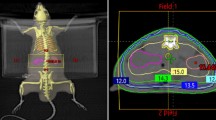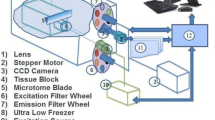Purpose:
To assess the degree of protective effects of amifostine on kidney functions via semiquantitative static renal scintigraphy and histopathologic analysis.
Material and Methods:
30 female albino rats were divided into three equal groups as control (CL), radiotherapy alone (RT), and radiotherapy + amifostine (RT+AMI). The animals in the CL and RT groups were given phosphate-buffered saline, whereas the animals in the RT+AMI group received amifostine (200 mg/kg) by intraperitoneal injection 30 min before irradiation. RT and RT+AMI groups were irradiated with a single dose of 6 Gy using a 60Co unit at a source-skin distance of 80 cm to the whole right kidney. They were followed up for 6 months. CL, RT, and RT+AMI groups underwent static kidney scintigraphy at the beginning of the experiment and, again, on the day before sacrificing. Histopathologically, tubular atrophy and fibrosis of the kidney damage were evaluated.
Results:
After irradiation, the median value of right kidney function was 48% (44–49%) and 50.5% (49%–52%) in RT and RT+AMI groups, respectively (p = 0.0002). Grade 1 kidney fibrosis was observed to be 60% in the RT group, while it was only 30% in the RT+AMI group. Grade 2 kidney fibrosis was 30% and 0% in the RT and RT+AMI group, respectively. Grade 1 tubular atrophy was 70% and 50% in the RT and RT+AMI group, respectively. Grade 2 tubular atrophy effect was the same in both groups (10%).
Conclusion:
Static kidney scintigraphy represents an objective and reproducible method to noninvasively investigate kidney function following irradiation. Amifostine produced a significant reduction in radiation-induced loss of renal function.
Ziel:
Beurteilung der protektiven Wirkung von Amifostin auf die Nierenfunktion mittels semiquantitativer statischer szintigraphischer und histopathologischer Analyse.
Material und Methodik:
30 weibliche Albinoratten wurden in drei Gruppen mit jeweils zehn Tieren aufgeteilt: Kontrolle (CL), alleinige Radiotherapie (RT) und Radiotherapie + Amifostin (RT+AMI). Die Ratten in der CL- und RT-Gruppe erhielten eine Plazebosalzlösung, die Ratten in der RT+AMI-Gruppe 200 mg/kg Amifostin intraperitoneal 30 min vor der Bestrahlung. Die rechten Nieren in der RT- und RT+AMI-Gruppe wurden mit 6 Gy Einzeldosis mit einem 60Co-Gerät bestrahlt. Die Nachbeobachtungszeit betrug 6 Monate. Eine Nierenszintigraphie wurde direkt vor der Bestrahlung und vor Sektion bei den Tieren der RT- und RT+AMI-Gruppe durchgeführt. Der Nierenschaden wurde in der histopathologischen Untersuchung mit Tubulusatrophie und Fibrose qualitativ beurteilt.
Ergebnisse:
Die mediane Nierenfunktion der rechten Niere betrug in der RT- und RT+AMI-Gruppe 48% (44–49%) und 50,5% (49–52%; p = 0,0002). Grad-1-Fibrose lag in der RT-Gruppe bei 60% und in der RT+AMI-Gruppe bei 30%. Grad-2-Fibrose betrug in der RT-Gruppe 30% und in der RT+AMI-Gruppe 0%. Tubulusatrophie Grad 2 war in beiden Gruppen vergleichbar (10%).
Schlussfolgerung:
Die statische Nierenszintigraphie ist eine objektive, wiederholbare und nichtinvasive Methode zur Beurteilung der Nierenfunktion nach Bestrahlung. Im Tiermodell konnte Amifostin die strahleninduzierten Nierenschäden verringern.
Similar content being viewed by others
Author information
Authors and Affiliations
Corresponding author
Rights and permissions
About this article
Cite this article
Kaldir, M., Cosar-Alas, R., Cermik, T.F. et al. Amifostine Use in Radiation-Induced Kidney Damage. Strahlenther Onkol 184, 370–375 (2008). https://doi.org/10.1007/s00066-008-1777-7
Received:
Accepted:
Published:
Issue Date:
DOI: https://doi.org/10.1007/s00066-008-1777-7




